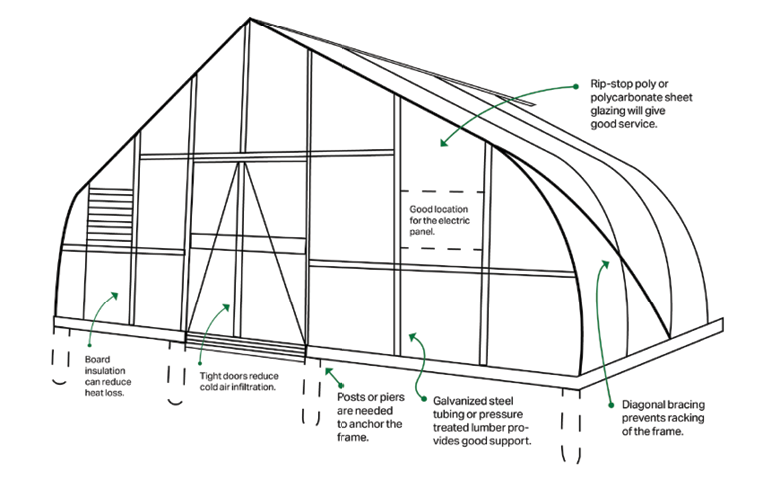
Endwalls are usually the most difficult segment of the greenhouse to construct. They have curved surfaces, doors and vents, and the glazing needs to be fitted to different surfaces. Here are a few things to consider when building one.
Material
Square, galvanized steel tubing allows easy attachment of doors, fans, shutters and other equipment. Pressure-treated lumber is a good alternative that may be easier to work with and a little less expensive. Both are strong and have a good service life.
Anchor
The flat wall surface can be subject to a heavy wind load; therefore, the endwall must be anchored to the ground and secured to the greenhouse frame. An acceptable method is to extend the posts into the ground and fill around them with concrete. An alternative is to anchor the post to concrete piers that extend below the frost line.
Bracing
To keep the wall vertical and resist the wind load, bracing is needed. Steel tubing braces should attach to the sidewall ground posts at least 8 feet from the endwall. The braces should then extend diagonally to attach at least halfway up the endwall to provide good bracing. A secure attachment at each end is needed. These will keep the whole greenhouse from racking (or tilting) end to end.
Glazing
Single- or double-wall polycarbonate is common endwall material. It has a more than 20-year life as compared to 6 mil poly that has to be replaced every four to five years. The double material reduces heat loss by about 35% compared to single-thickness material. It is easy to install with aluminum extrusions. If poly is used, better service life is obtained from rip-stop material.
Insulation
In northern climates, insulation will help reduce heat loss. Installing 1-inch-thick aluminum-faced board insulation to about bench height will provide some heat savings without affecting plant growth. Research has shown that there is considerable loss of light that enters the greenhouse when the whole wall is insulated.
Doors
Doors are needed for personnel and equipment access. Commercial, pre-hung insulated doors give the best service. Homemade doors need to have good weatherstripping; otherwise, there is considerable infiltration of cold air. Hinged doors are better than sliding doors, as they close tighter. A concrete or pressure-treated door sill needs to extend below the frost line to prevent lifting.
Electric panel
The endwall is a good location for the electric panel. It provides a dry place for the breaker box, switches, irrigation system controls and temperature alarm. If installed correctly and to code, it will be reliable and convenient.
With these considerations and thoughtful planning, proper endwall construction can keep your growing structure solid and dependable for years to come.

Explore the August 2024 Issue
Check out more from this issue and find your next story to read.
Latest from Produce Grower
- Your comprehensive guide to Indoor Ag-Con ’25
- Sollum Technologies and Indoor Ag-Con announce recipients of Sollum Student Scholarship
- 80 Acres Farms expands to Georgia, Texas and Colorado
- This fast and agile robotic insect could someday aid in mechanical pollination
- AmericanHort urges exclusion of sphagnum peat moss from proposed Canadian tariff
- The Growth Industry Episode 2: Emily Showalter on how Willoway Nurseries transformed its business
- Moleaer expands irrigation product line featuring nanobubble technology
- Eden Green Technology CEO Eddy Badrina reflects on challenges, opportunities for CEA





